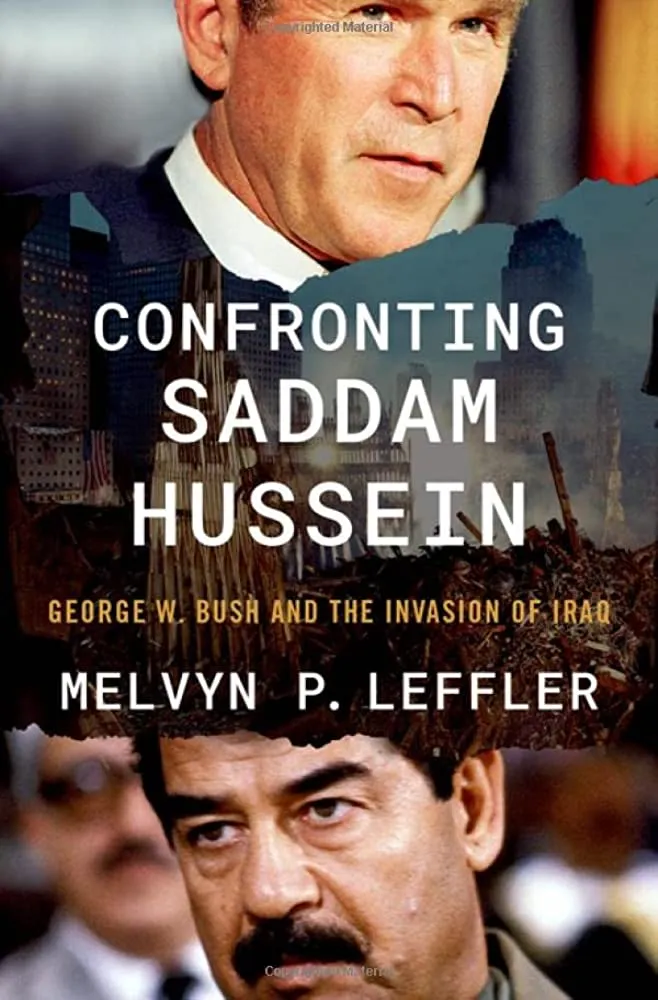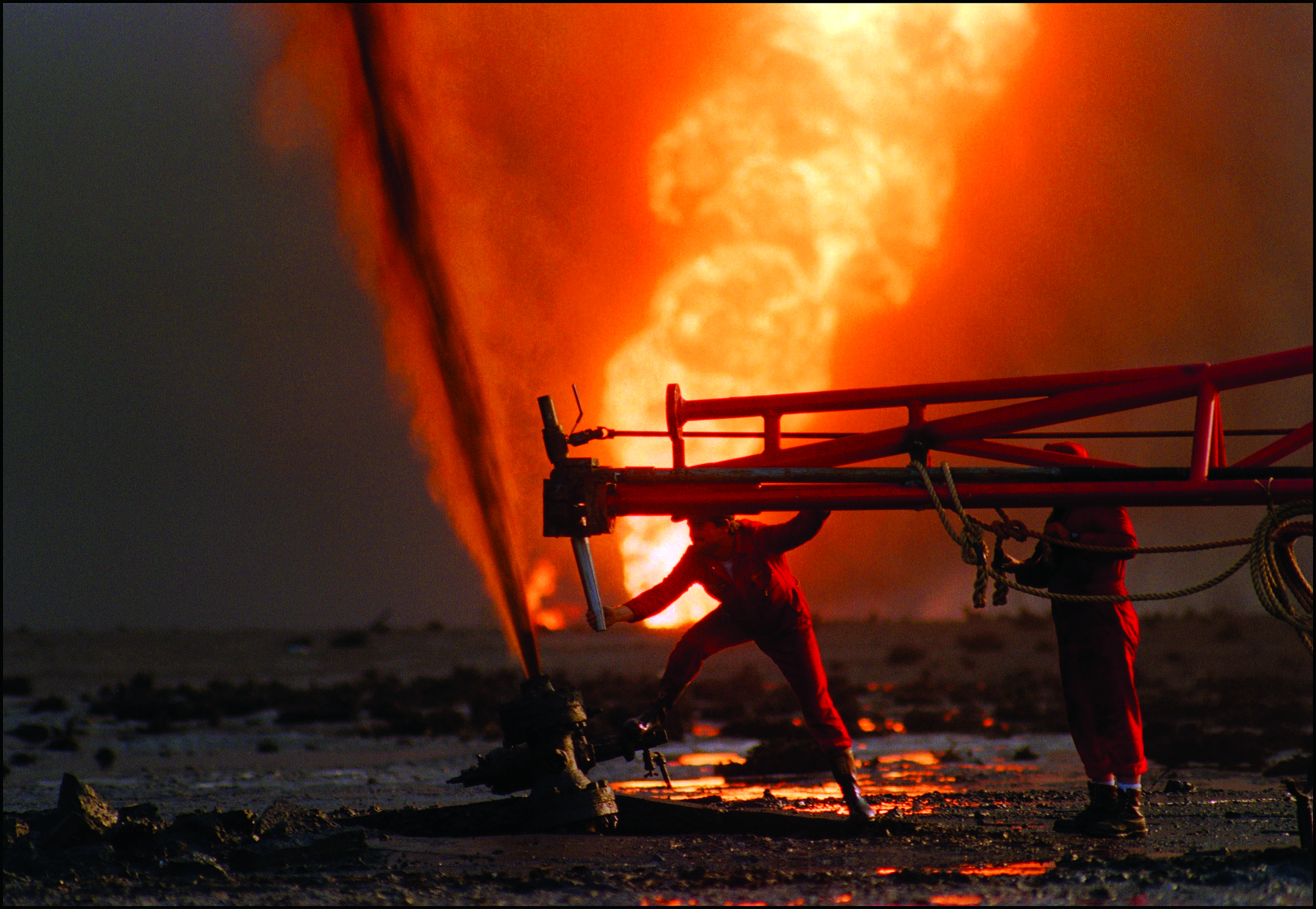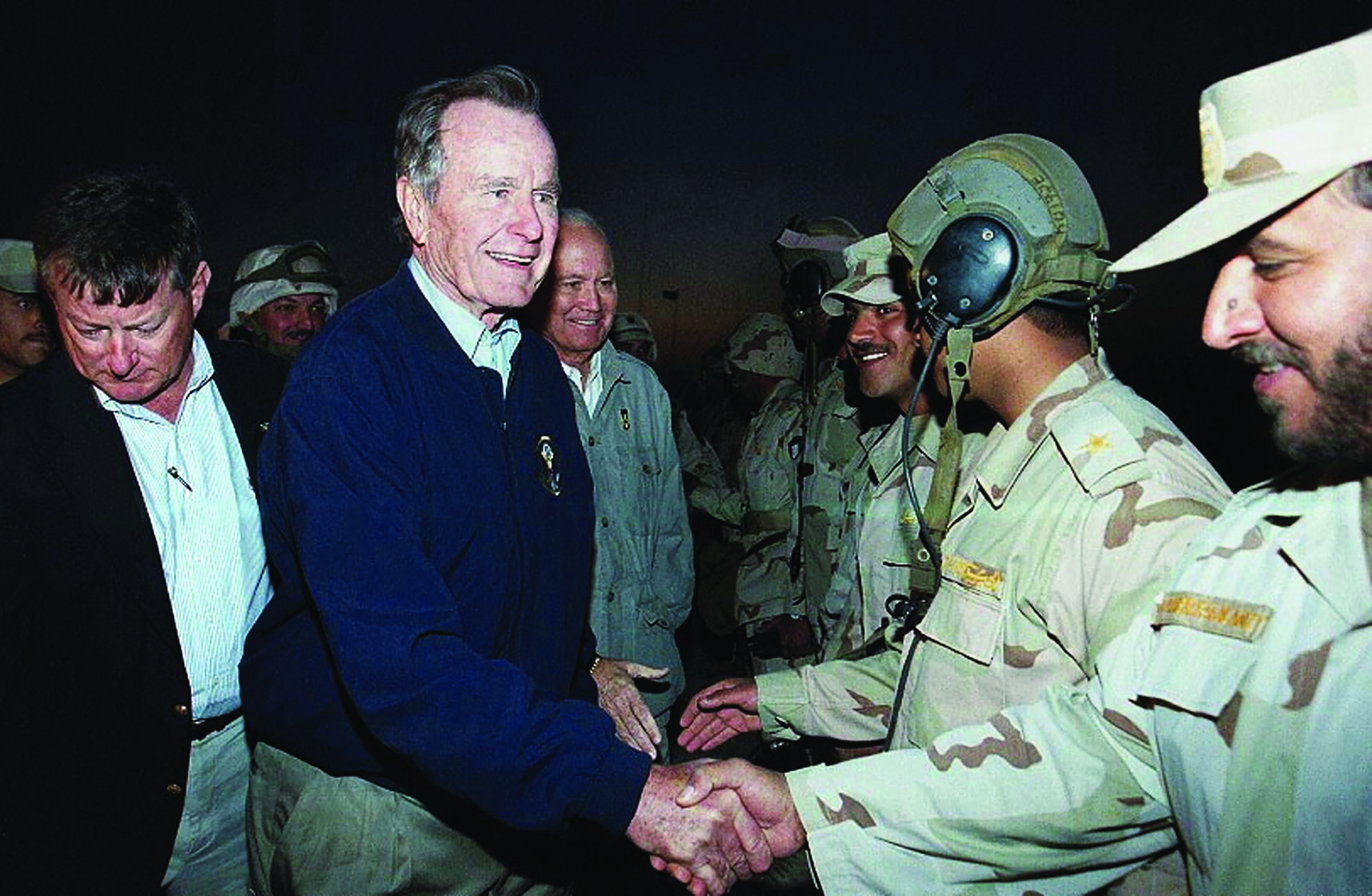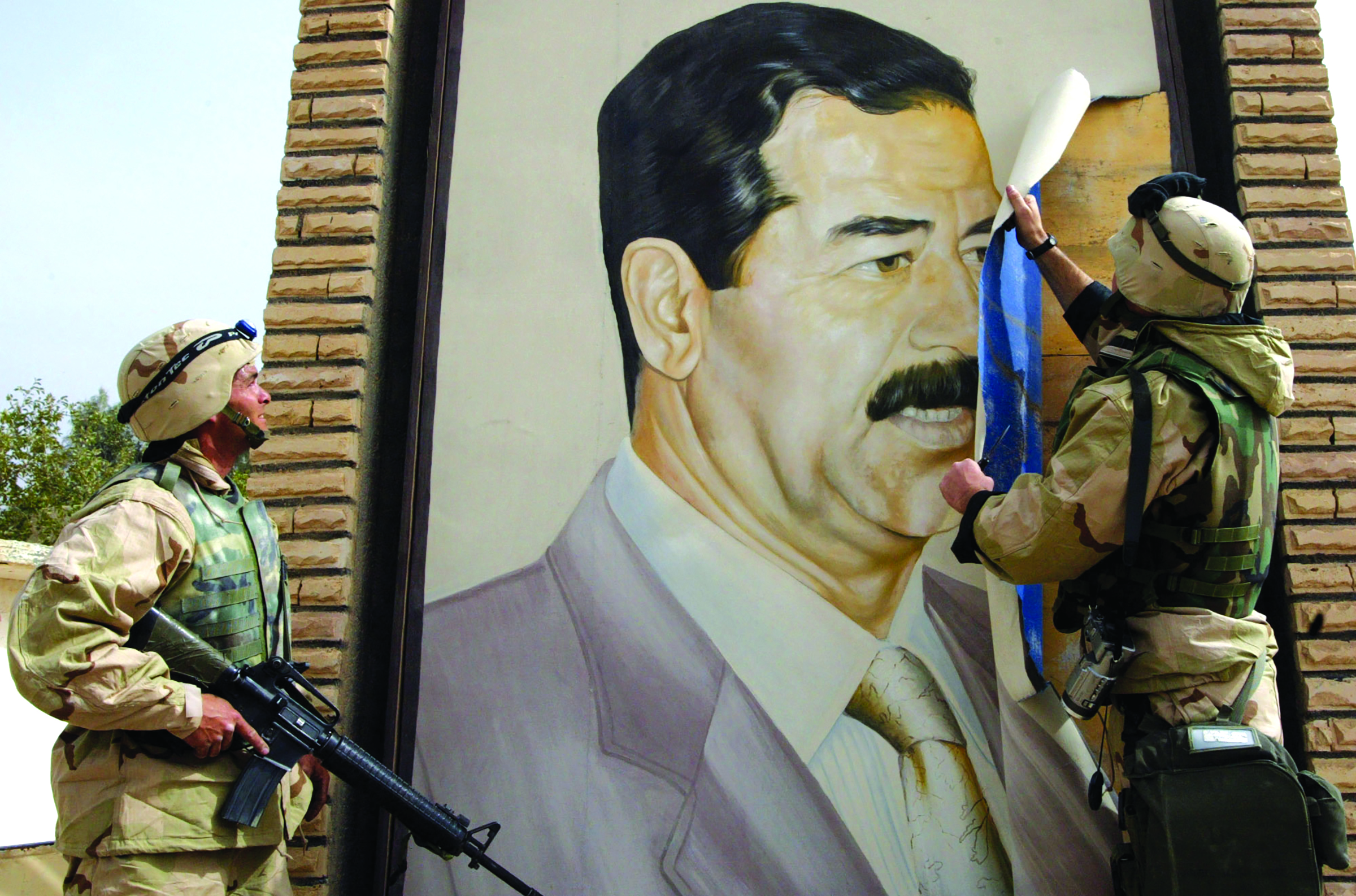The surest proof that the Iraq War ended in disappointment and failure is that it has receded into history as an orphan: “George W. Bush’s war,” as it came to be known. As we mark its 20th anniversary, the gradual narrowing of responsibility has become one of several key myths with which we should dispense once and for all. One might be forgiven for assuming that the terrible misfortunes of the Iraq War came by way of a hitherto-obscure faction of neoconservatives. The culpability of this faction has become a dogma of the progressive Left as much as it has of the post-Trump Right. In this telling, the good and great American people were little more than bystanders to the ruinous idealism that sought to export democracy at the point of a gun. After emerging morally untainted, they have been justly chastened about the limits and the iniquities of American power ever since.

This storyline obscured a salient truth about the war that has since been all but forgotten: namely, that it had been a national enterprise. Before U.S. soldiers took the field, a broad array of America’s political leaders, including every subsequent presidential nominee of each party who had been in Congress at the time of the war, blessed this campaign in the Arab world.
Rightly or wrongly, the war proceeded from all-too-common assumptions that had informed successive administrations and that had been endorsed enthusiastically by Congress as well as a solid majority of the public. It was the logical consequence of deep-seated American attitudes about the United States’s own power and responsibilities in the world. It flowed, in other words, from America’s national character and the nature of its role in the global order, from the traditional strategic concepts and objectives of the U.S. national security bureaucracy.
WHAT IS THE MOST IMPORTANT LESSON OF THE IRAQ WAR?
Few accounts of the Iraq War to date have addressed themselves to what Raymond Aron, writing to Max Weber, called the question detaining all amateur politicians: “What would you do if you were a Cabinet minister?” The war’s architects didn’t have the luxury of knowing what we now know. For 20 years, a searching and fair-minded report that assimilates this crucial point has been conspicuous by its absence, to the detriment of public understanding about the intended and unintended consequences of this conflict.
Until now. On this anniversary, a study of rigorous and refreshing honesty has arrived that may at last rescue this conflict from the sewer of prejudice and contempt in which it has languished for so long. In Confronting Saddam Hussein, Melvyn Leffler, an eminent historian of U.S. foreign policy, brings remarkable forensic skill to bear on the decision to depose the tyrant who aspired to be an Arab hero and conqueror, styling himself as a new Saladin. Leffler does so without indulging the false and easy temptations of anti-war polemics who have disfigured the nation’s memory of this confrontation.
The opening pages of Confronting Saddam Hussein make clear that the book has a dual purpose: to examine why the Bush administration decided to invade Iraq and to grapple with why the war went awry. The answer to the first query revolves around the dictator’s inveterate “defiance, treachery, and barbarity.” The decision to employ “coercive diplomacy” and finally outright force cannot be understood without accounting for the tyrant’s own “role and agency.”

Leffler’s research into the despot from Iraq’s Sunni hinterland lays bare that Saddam had a lifelong ease with violence mingled with an insatiable appetite for power. In this, he lived up to his given name, which means “one who confronts.” In the revolutionary Baghdad of his youth, Saddam had a penchant for brutal political street fighting that prefigured his brutish regime years hence. After a bungled assassination attempt against Iraq’s nationalist leader, he went into exile in Damascus, where he made the acquaintance of the Syrian founder of the Baath Party, Michel Aflaq. This political faction, developed in the 1930s under the influence of European fascism, gave Saddam an expedient vehicle for his goals of unifying the Arab world to extinguish the “Zionist entity” and thwarting Shiite Iran while achieving total control over Iraq.
To convey the radical evil at the heart of a regime that was modeled on those of Hitler and Stalin, Leffler puts special emphasis on Saddam’s ascendency after returning to Iraq. Within a fortnight of coming to power, Saddam convened a meeting of the Baath Party leadership. With cameras rolling, a loyal underling began the proceedings by announcing the existence of an “atrocious plot” in which the conspirators were said to be present. As Saddam sat nonchalantly at the front of the room chewing on a cigar, an old party rival bearing the signs of torture at the hands of Saddam’s henchmen was dragged in to render a confession of treason and subversion. The names of 66 supposed collaborators were haltingly recited, and one by one, they found themselves led away. Fear and panic began to spread until the remaining delegates, undone by dread, broke out into hysterical chants of “Long live Saddam!”
Subsequently, in the courtyard of the building where the Baath purge from within began, 22 of the offenders had been selected for execution. The punishment would be meted out by the delegates themselves, to whom Saddam personally handed pistols. The condemned knelt with blindfolds while the executioners proceeded with their grisly work. The central committee of the party, now complicitous with the terrible deed, had instated and consecrated a totalitarian dictatorship — a personality cult to which history’s greatest monsters would bow in respect.

In the ensuing decades, Saddam would seek the domination of the Middle East, devoting much of Iraq’s vast petroleum revenue to purchase the instrumentalities of war. He was brazen enough to pursue weapons of mass destruction in the face of daunting obstacles. In 1975, the Baathists had consummated a deal with French Premier Jacques Chirac to acquire a nuclear reactor that was later wrecked by an Israeli airstrike. Not even this brush with foreign military intervention on Iraqi soil spelled the end of Saddam’s nuclear aspirations, which, as he would later confess to his U.S. interrogators, never ceased. Declaring that “the boundaries of our aims and ambitions do not lie in Iraq but extend through the whole Arab homeland,” Saddam was not a dilettante in the realm of predatory aggression. Over the life of his regime, he never relented in his pan-Arab project and didn’t hesitate to resort to arms to reinforce it.
Leffler is at his best when writing about Saddam’s unrestrained lust for power and the incessant tussle that followed between him and various regimes in the Middle East and beyond. In 1980, Saddam unleashed a bloody war with the Islamic Republic of Iran in which the U.S. supported both sides in the hope that both would lose. And they did: Before the guns fell silent, more than a million soldiers and civilians on both sides had perished for no discernible purpose. Iraq employed chemical weapons against both Iranian cities and the restive Kurdish minority of northern Iraq. The notorious Anfal campaign earned the Iraqi Baath Party the dubious distinction of being the first regime in history to attack its own civilian population with chemical weapons. (A quarter-century later, the Syrian Baathist clique of Bashar Assad became the second.)
In July 1990, just two years after the ceasefire with Iran, Saddam turned his sights on Kuwait. Citing a list of rebuffed demands for the petroleum-rich emirate to hike oil prices and reimburse Iraq for losses in the Iran War, Baghdad dispatched its legions to plunder and annex the former Iraqi province. In the face of a mighty international coalition, Saddam seized hostages among the expatriate community inside Iraq, launched Scud missiles into Israel, raided a border town in Saudi Arabia, and threatened the use of his chemical arsenal. These gratuitous provocations, intended to split the coalition coalescing against him, served only to solidify it.
Within months, the U.S. deployed more than 500,000 of its troops to the gulf. In January 1991, U.S. air power struck Iraqi command centers and defense systems as well as the presidential palace and Baath Party headquarters. This show of force led Saddam to set Kuwaiti oil fields ablaze. The vast U.S. expeditionary force, in accord with the letter of U.N. Security Council resolutions authorizing the expulsion of the Iraqi army from Kuwait, was ordered into battle and routed the enemy in 100 hours.
In the war’s aftermath, the Iraqi dictator acquiesced to the terms imposed by the United Nations to withdraw his forces, recognize Kuwaiti sovereignty, and disclose and eliminate his weapons of mass destruction — while permitting U.N. inspectors to monitor Iraqi compliance. But when the fearsome Republican Guard emerged unscathed and his apparatus of terror remained largely intact, Saddam proclaimed victory. Just across the border from coalition forces, Iraq crushed a Shiite rebellion in the south and another Kurdish rebellion in the north. In response, the U.S. and the United Kingdom, and initially France, instituted no-fly zones — without a U.N. mandate. Over the next dozen years, more than 300,000 Anglo-American sorties were made to prevent the repetition of mass slaughter, and these patrols were fired upon regularly.
The record of Iraq’s near-suicidal aggression and intransigence, including the assassination attempt on former President George H.W. Bush during a postwar visit to Kuwait, is made plain in Confronting Saddam Hussein. Instead of disclosing and destroying his WMD and long-range missiles after 1991, Saddam’s untamed nature reasserted itself. Judging this poisonous arsenal to be critical not only to his own immediate survival and that of his gangster regime but also to deter and blackmail his actual and potential adversaries forever more, he sought to preserve his illicit arms cache and the capabilities to augment it in the future on a grand scale.

The U.N. and International Atomic Energy Agency weapons inspectors faced systematic and perpetual obstruction in the form of a concealment committee run by the despot’s second son, Qusay Hussein. This didn’t stop the inspectors from confirming the existence of a nuclear program far more advanced than they had known or expected. (Saddam had initiated a crash program in 1990 to acquire a nuclear weapon in less than a year.) These findings elicited modest concessions from Baghdad, but it refused to cooperate fully with the arms inspectors and failed to account for numerous prohibited items for the duration of the inspection regime.
At the same time that containment was breaking down, the sanctions were being systematically eroded by the U.N.’s oil-for-food scheme that Saddam cheated to expand funding for proscribed activities. The Baathist regime’s truculence continued until December 1998, when it expelled the weapons inspectors who insisted that Iraq had not destroyed its bacteriological agents, disclosed all its chemical programs, or renounced its atomic ambitions.
U.S. and British forces responded to Iraq’s breach of its commitments by launching a barrage of cruise missile attacks against suspected chemical weapons sites and Iraqi command-and-control. By Bill Clinton’s own admission, however, this bombardment had not conclusively destroyed the illicit weapons program — and failed as well to bring Saddam to heel. Having survived another skirmish with American power and without intrusive inspectors to contend with, Baghdad sought, with French and Russian collusion, to break free of sanctions and reconstitute its WMD programs.
The combination of Saddam’s inveterate ambition and enduring enmity made him, to borrow from Thucydides, a “convenient enemy” for the U.S. People may choose to forget it now, but the breadth of U.S. support for the intervention — 72% of Americans favored the war in mid-March 2003 — was hardly surprising. Regime change, though implemented by President George W. Bush, had become U.S. policy during the Clinton administration.
In 1998, a series of deliberate Iraqi provocations — challenging Anglo-American no-fly zones, evicting U.N. weapons inspectors, and abetting international terrorism — prompted Congress to pass the Iraq Liberation Act, which proclaimed that U.S. policy was “to support efforts to remove the regime headed by Saddam from power in Iraq and to promote the emergence of a democratic government.” The vote was 360-38 in the House and unanimous in the Senate. Although this enthusiastic support for regime change in Baghdad among both Democrats and Republicans in Congress and by a Democratic president faded from memory, it’s solid historical proof that a wide national consensus had deemed Iraq to be a grave national security challenge as long as Saddam remained in power.
Less than three years later came 9/11. Al Qaeda’s brazen attack did nothing to allay fears about the special nexus of dangers presented by Saddam, not least because the Iraqi despot was the only world leader to praise the jihadi operation. The atrocity would loom large in Washington’s revised security assessments, making America’s most convenient enemy look more and more like an intolerable one. This was not because Saddam had a hand in that deed of terror (he did not) but rather that he personified the culture of autocracy and radicalism from which it had sprung. Beyond al Qaeda, which would be decimated in the Hindu Kush, Iraq appeared to be the most likely conduit of a future attack, especially one conducted with unconventional weapons. America’s governing class believed that, as Leffler cited one official, it might be forgiven “one surprise attack, but not a second.”
The danger of postponing a final confrontation with Saddam in the post-9/11 era was evident to even an amateur strategist. Despite the ambivalent evidence about the condition of Iraq’s arsenal, it strained credulity to conclude that the Baathist regime was entitled to the benefit of the doubt. The timing of the decision to confront the world’s most ruthless and bellicose despot was critical. The longer such a reckoning was put off, the greater the risk that he would exploit the West’s indecision (or failure of nerve) and gain a windfall of strategic advantages.
Saddam’s expressed ambitions were boundless while he embarked on a tireless quest for lethal weapons and malevolent networks to work his wicked will. The specter of such a regime acquiring WMD was nothing short of terrifying. Although this lethal arsenal, actual and potential, served as the centerpiece in the public case for war, a host of reasons were cited in the authorization of the use of military force. In October 2002, both houses of Congress passed 23 writs justifying war in Iraq, an update of Clinton’s 1998 Iraq Liberation Act.
The fact that no stockpiles of WMD were ever found would be cited ad nauseam by the anti-war faction as proof that a false pretext had been used to justify the invasion. But the covert weapons programs were latent, and anyway, the absence of stockpiles was not the same as an absence of intent. Shortly before the end of the regime, for instance, Iraqi envoys were meeting in Damascus with North Korean officials to procure Rodong missiles, which have a range much greater than what had been prohibited to Iraq by the U.N. resolutions, from Pyongyang. And shortly after the fall of the regime, to cite one particularly lurid finding, parts of a nuclear centrifuge were unearthed in a scientist’s garden in Iraq, buried on the orders of Saddam’s son Qusay.
On the sensitive matter of Saddam’s arsenal, Leffler pointed out that not even the Bush administration’s most pugnacious policymakers conceived of it as an immediate threat to the U.S. or its interests. Rather than being the imminent danger that overzealous advocates of regime change alleged, Iraq’s pursuit of weapons with deterrent power presented a looming peril that was inextricably connected to the character of its regime and would therefore remain in place until it was removed. In this light, perhaps the best answer to the question “Why invade Iraq?” seemed to be: What if we don’t? A sober analysis of this lingering confrontation reminds us that indecisiveness in international affairs can be the most enfeebling of sins. The principal architects of the war in Iraq, acutely aware of past calamities and convulsed by anxious foresight, recognized that diplomacy has a limit, as much as does force.
The leading lights of the Democratic Party were no exception. As Leffler’s research reminds us, Sen. Joe Biden, then the Democratic chairman of the Foreign Relations Committee, declared his fears about the proliferation of weapons of mass destruction as long as Saddam stayed on the throne. Long before the war, Biden argued in congressional hearings that “Saddam has got to go.” For those who might imagine him confessing a theoretical desire rather than propounding a concrete policy, something akin to his recent claim in Warsaw that Russian President Vladimir Putin “cannot remain in power,” the future president clarified that this objective would require “U.S. force.”
CLICK HERE TO READ MORE FROM THE WASHINGTON EXAMINER
And so, contrary to tendentious myths propagated by demagogues in the Democratic Party, and later in former President Donald Trump’s Republican Party, that the Iraq War was “cooked up in Texas” or, more fatuously, by a shady cabal of neoconservatives, it shouldn’t be forgotten that it was a veritable national undertaking. Toppling Saddam was no exercise in misty-eyed idealism — its broad domestic support owed in large measure to its advancement of the vital interests of state, as those were understood in relation to America’s stake in a decent and durable global order.
Two decades later, the Iraq War is still here, still at the center of our conceptions of interventionism and internationalism, still demanding, insatiably, to be dealt with. The buyer’s remorse that settled upon this war so soon after America struck into Iraq was a dishonorable compulsion to abandon an earnest and solemn commitment. But it also fostered a parochial vision of American power and purpose in the world that continues to work its distortions on the public understanding of statecraft in an age of gathering challenges to world order.
Brian Stewart is a New York-based political writer.

